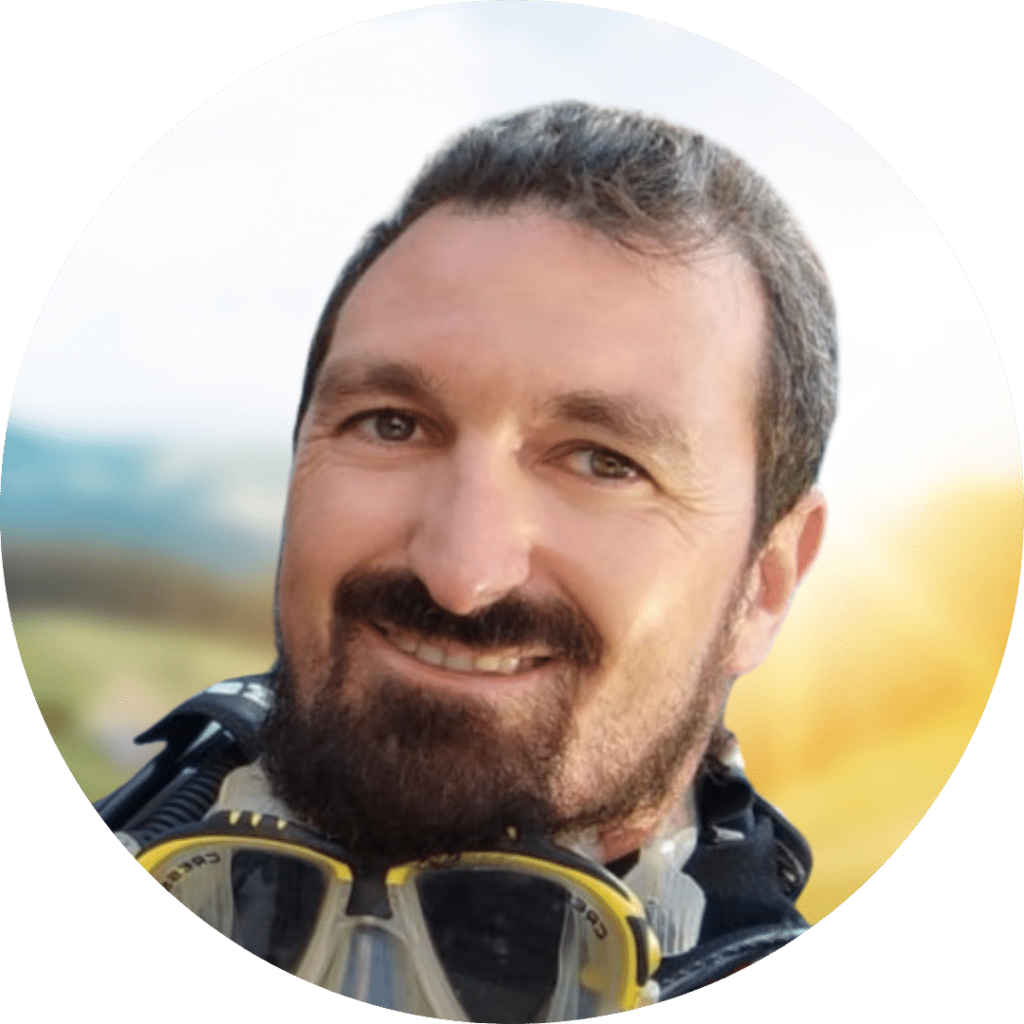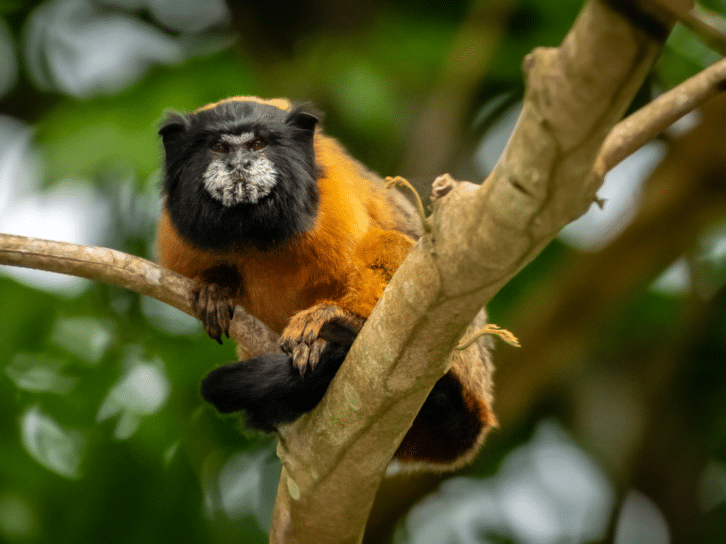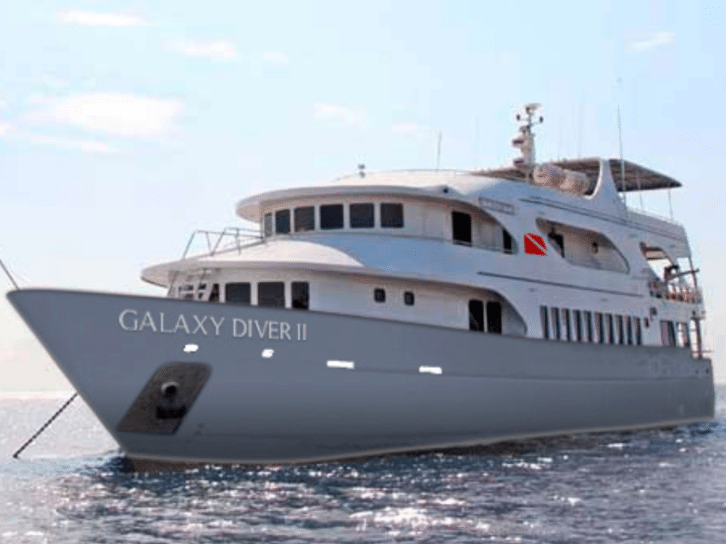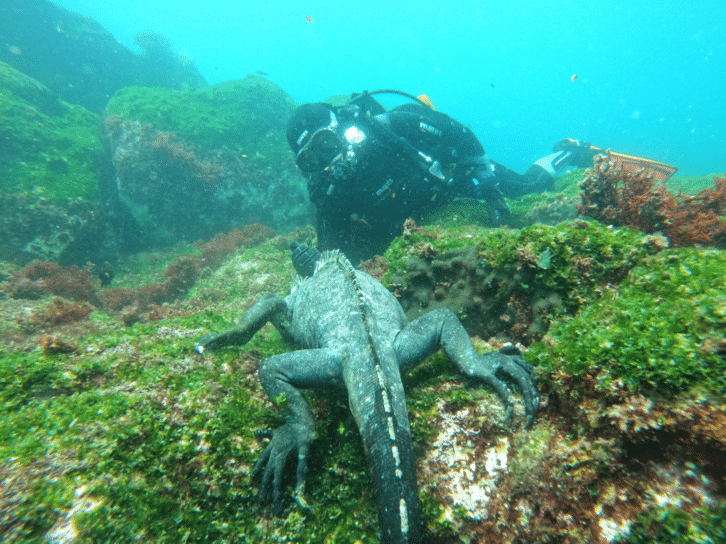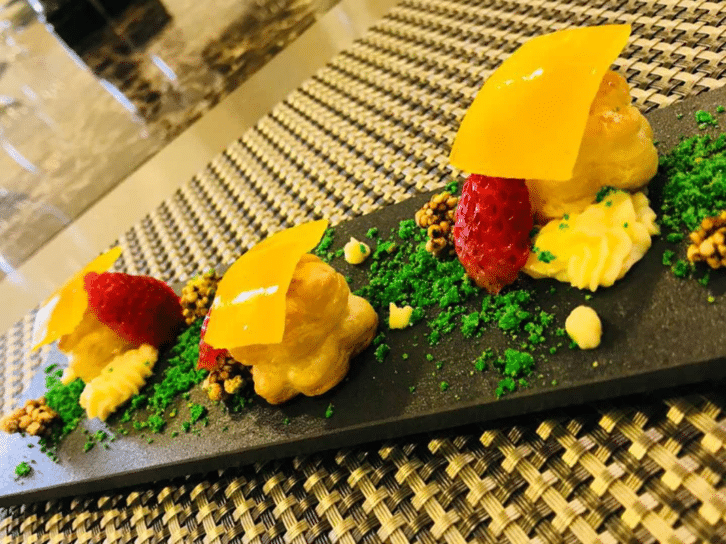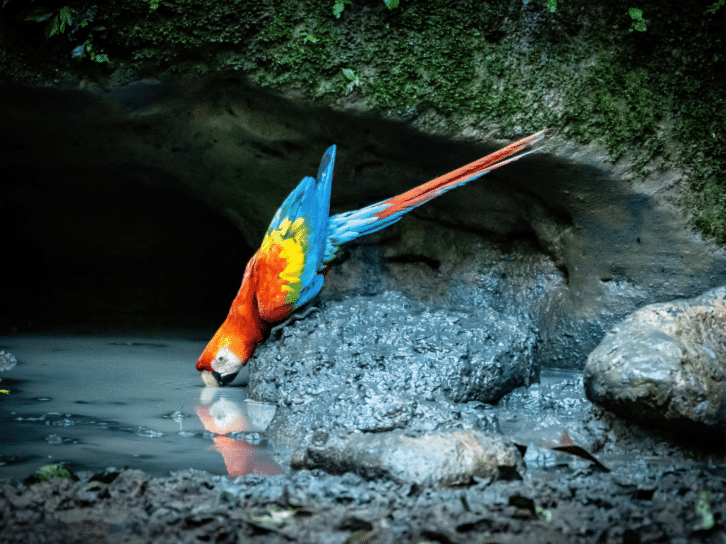Galapagos Master – Liveaboard & San Cristobal Extension
Travel period
Features
Starting from
Liveaboard & stay in the Galapagos Islands
This trip combines a fantastic week of liveaboard diving on the Galapagos Master at the most famous dive sites in the Galapagos, such as Wolf and Darwin. After the liveaboard you will stay 4 days on San Cristobal and enjoy beautiful excursions above water.
Diving in the Galapagos
The first part of the trip you will dive on a luxury liveaboard at famous sites as Darwin and Wolf. Here you will dive with hammerhead sharks, rays, turtles, penguins, marine iguanas and sea lions. In the right season, you’ll also spot whale sharks (Jun-Nov)! You will also dive at the spot where Mola Molas are spotted. This variety of marine life is the reason the Galapagos Islands are on many divers’ bucket lists. During this trip you will stay aboard the Galapagos Master, a luxurious and comfortable boat with a very good reputation.
Discover San Cristobal
Following this trip, you will stay another 4 days on San Cristobal, where you will have an excursion program with a visit to Loberia (sea lions and marine guinea pigs). There are also opportunities to visit Kicker Rock, Española and a 360-degree tour of the island. This makes for a perfect combination of diving and exploring the unique nature of the Galapagos.
At EWDR we provide tailor-made diving holkidays, so you can also stay longer on San Cristobal or, for example, choose an extension on one of the other islands. Santa Cruz and Isabela are also among the possibilities!
Best travel time for diving in the Galapagos Islands
January to May is the “warm” season on the Galapagos, characterized by calm oceans and favorable diving conditions, ideal for beginners and diving with manta rays. Water temperatures range from 24-28°C, with daily air temperatures of 25-28°C and variable weather. During this period, water productivity is low, making large animals such as whale sharks less common. Hammerhead sharks do tend to still be there in large numbers.
June to November is the “cold” season, influenced by the Humboldt Current, with colder waters (19-23°C) and more marine megafauna, such as whale sharks and hammerhead sharks. Daily air temperatures range from 21-24°C, with often gray skies and fog.
➤ Due to the sometimes very strong currents, only experienced divers are allowed on this liveaboard. You must hold Advanced Certification and have a minimum of 50 (preferably 100) logged dives. A nitrox certificate is highly recommended so you can do all the dives at Darwin & Wolf. In the past 6 months, prior to the liveaboard, you must have at least logged one dive.

Average Temperatures
Wetsuit advice for diving Galapagos Islands
![]() We recommend a 7mm wetsuit + cap + hood.
We recommend a 7mm wetsuit + cap + hood.
What will you experience on this diving holiday?
View itinerary here
Day 1 & 2 | Travel to Ecuador
Today your adventure begins with a flight from Europe to Quito or Guayaquil. Several flight routes are available, often with a short transfer. At EWDR, we are happy to think with you about the best options, but you can also book your flight yourself. Total travel time is between 11 and 15 hours. Upon arrival, you will be picked up and transferred to a comfortable hotel near the airport, where you can relax and recover from the long journey. This is the beginning of an unforgettable diving holiday in the Galapagos Islands. After a good night’s sleep and breakfast at the hotel, you are ready for the next part of your journey.
Day 3 | Arrival at San Cristobal
Today you will fly from mainland Ecuador to the Galapagos Islands, San Cristobal, arriving in the early afternoon. The crew of the Galapagos Master will meet you personally, pick up your luggage and escort you to the liveaboard, where your luggage will be taken to the dive deck. Once all guests are on board, there will be an introduction to the boat, safety briefings and drills. You will then sail to Los Lobos for your check-out dive, where you will meet playful sea lions and fur seals. So on the first day, you will already see the diverse land formations and unique underwater world of the Galapagos.
© Mike Suender
Day 4 | Carrion Point & North Seymour Excursion
Today you will start the day with a dive at Carrion Point. This location on the east coast of Santa Cruz juts out into the ocean, creating a sheltered cove ideal for snorkeling and diving. The sheltered, crystal-clear waters offer views of a wide variety of marine life, including rays, sharks and numerous tropical fish.
After the dive, sail on to North Seymour for a land excursion. The island was created by a series of undersea lava flows with sedimentary layers lifted by tectonic activity. On North Seymour Island, you will encounter Galapagos sea lions, blue-footed boobies, land iguanas and magnificent Frigatebirds. The island is characterized by its dry vegetation zone, which makes for a special view.
© Mike Suender
© Mike Suender
Day 5 & 6 | Darwin Island
For the next two days, you will dive at Darwin Island, an extinct volcano 165 meters above sea level named after the famous naturalist Charles Darwin. This is one of the smallest islands in the Galápagos Archipelago and as with Wolf Island, land visits are not allowed here.
One of the most famous dive sites is “Darwin’s Arch.” Here you will make fantastic drift dives along the wall at an average depth of only 9 meters. Expect medium to strong currents, which bring large numbers of hammerheads, blacktip sharks, silky sharks and Galápagos sharks. You often see schools of jacks, as well as turtles, angelfish and moray eels. Occasionally you may also see tiger sharks, manta rays and bottlenose dolphins. Between May and November, there is even a chance to spot whale sharks. Although the top of the iconic arch formation collapsed due to natural erosion on May 18, 2021, the pillars still stand and the surrounding dive area remains untouched and full of impressive marine life. Today, the dive site is also called Darwin’s Towers.
You will also go diving at El Arenal. This dive site, close to Darwin’s Towers, is known as one of the best in the world. You can expect moderate to strong currents. Here you will be welcomed by an impressive underwater biodiversity, including schools of hammerhead sharks, Galápagos sharks and with a little luck you will also spot a whale shark.
© Mike Suender
© Daniel Perrazo
© Mike Suender
© Daniel Perrazo
Day 7 | Wolf Island
Today the whole day is dedicated to diving at Wolf Island. Named after German geologist Theodor Wolf, this extinct volcano reaches 253 meters above sea level and is located about 160 km northwest of Isabela Island. Land visits are not allowed, but from the boat you can spot bird species such as red-legged boobies and vampire finches.
At Wolf Island we dive on several reefs and walls with mostly moderate to strong currents, so gloves are recommended. Schooling pelagic fish are the main attraction, with regular sightings of hammerhead sharks, whitetip sharks and Galápagos sharks. Whale sharks may also be seen during the season. Also watch for red-lipped batfish, barracudas, moray eels and dolphins. Popular dive sites include El Durrumbe, La Ventana, La Banana, Punta Shark Bay, Anchorage, Hat Island and Pinaculos, each with unique features and varying currents.
© Mike Suender
© Mike Suender
Day 8 | Punta Vicente Roca & Cabo Douglas
Today you will start diving at Punta Vicente Roca, a great place to see the famous Mola Mola or “moonfish.” This site has a long, sloping underwater wall that extends to a depth of 28 meters. The shallower areas are rich in marine life, where you often see penguins frolicking gracefully around divers. Playful sea lions also often swim with snorkelers and divers here.
After these special dives, the Galapagos Master sails on to Cabo Douglas on the west coast of Isabela Island. Before you start the dive, you can see cormorants, penguins and marine iguanas, unique species found only in this archipelago. During the dive, you will see the marine iguanas ‘ powerful swimming skills while the larger males forage on the rocks deeper below the water’s surface. Sometimes you can even see baleen whales gliding through the water.
Mike Suender
Day 9 | Cousins Rock & Santa Cruz excursion
On your last day of diving in the Galapagos Islands, two more dives are scheduled in the morning. The first and last dive takes you to Cousins Rock, one of the most colorful dive sites in the archipelago. The vibrant walls and gorgonians provide a wonderful backdrop for encounters with seahorses, reef fish and various nudibranchs. Diving deeper, you might see a school of eagle rays gliding or a white tip shark resting in a crevice between the rocks. With luck, you’ll even spot mobulas and schools of barracuda. Finally, the playful sea lions will make one more appearance.
In the afternoon, head to a reserve in the highlands of Santa Cruz. There you will have the chance to see the iconic Galapagos turtle in its natural habitat. While strolling through the lush vegetation, you might also encounter other local residents, such as the rare Galapagos dwarf grunt or the bright red Vermilion Flycatcher.
Day 10 | Land Program San Cristobal - Loberia excursion
After breakfast, it is time to leave the Liveaboard Galapagos Master and check in at Casa Opuntia, the hotel where you will stay for the next 3 nights. Your guide will then pick you up at your hotel and accompany you to Playa Loberia.
Playa Loberia is just 10 minutes from downtown San Cristóbal. It is a 2.5 km long coral sand beach called “La Loberia” because of the Galápagos sea lions sunbathing on the rocks and sand. Take a walk along the 900-meter coastal path, where you can see marine iguanas and sea turtles. Along the way, you will also encounter button mangroves, white mangroves and Palo Santo trees.
Day 11 & 12 | Choice of 3 day programs
The next 2 days you can choose which of the day programs below you would like to do.
360 Tour: During the 360° Tour around San Cristóbal Island you will visit Rosa Blanca, Sardine Bay, Punta Pitt and Kicker Rock of Punta Puccuna. Enjoy snorkeling, where you can see small sharks, sea turtles and stingrays. Admire the unique geological formations and various animals, such as sea lions and colorful fish. The tour also includes stops for fishing and exploring beautiful scenery and birdlife.
Kicker Rock: Depart Puerto Baquerizo Moreno in the morning for Kicker Rock, a famous volcanic rock formation also called “Leon Dormido. In the channel between the rocks you can see sharks, rays, sea lions, turtles and various fish, ideal for snorkeling and diving. After a delicious lunch on the boat, visit a beautiful beach location and enjoy nature.
Española: Depart early in the morning from Puerto Baquerizo Moreno for Española Island, 35 km from San Cristóbal. Enjoy a day of activities at Punta Suarez and Gardner Island, where you will see endemic species such as the Española mockingbird and the wavy albatross. Visit rocky shores with Nazca and blue-footed boobies, Darwin’s finches and marine iguanas. Later you can snorkel at Gardner Island with playful sea lions and colorful fish. Enjoy a three-course dinner aboard the Galápagos Hopper Catamaran.
The Española tour is not available every day of the week.
Day 13 & 14 | Return home
Alas, it is already over. In the morning, you will check out of Casa Opuntia and be transferred to the San Cristobal airport. From here you will fly back to Quito or Guayaquil. Depending on your flight schedule, you may fly home the same day and arrive on day 14. If the connecting flight does not leave immediately, stay overnight in Quito or Guayaquil and fly the next day, arriving home on day 15.
Want to extend this fantastic trip even more? Then consider staying in the Amazon, as described in this trip, for an extra special experience.
The liveaboard
The ship and cabins
Galapagos Master
The Galapagos Master, known locally as Deep Blue, is a 32-meter liveaboard dive boat renovated to the highest standard in 2015 and again in 2023. With itineraries of 7 and 10 nights, the boat offers access to the best dive sites in the Galapagos.
With only 16 divers on board, the Galapagos Master offers a safe and comfortable experience. The eight cabins, spread over three decks, each have private bathrooms with hot water and ample storage space.
The common areas are spacious and comfortable. The lounge on the middle deck has a plasma TV for movies and viewing underwater photos. The dining area serves delicious meals, complemented by a cocktail bar. Photographers benefit from a dedicated camera docking station with multiple charging points and storage drawers.
The sun deck is perfect for sunbathers, while the shaded upper deck offers comfortable seating. The boat is officially licensed by the Ecuadorian government and meets all safety and environmental regulations of the park.
Classic Twin Cabin (2x): On the lower deck, with two single beds. No windows or portholes (anymore).
Classic Twin/Double Cabin (2x): On the lower deck, can be converted to two single beds or a double bed. No windows or portholes (anymore).
Premium Double Cabin (1x): On the middle deck, with a double bed.
Premium Twin/Double Cabin (4x): On the upper deck, with two single beds or one double bed, great views and private bathroom.
Travel costs
What is included
This diving holiday to the Galapagos Islands is available from €7579 per person based on two people in one room. The diving trip can be expanded as desired. A number of things are included by default in this travel package.
Prices are subject to price changes, increases or changing exchange rates. Flights are always based on the cheapest possible booking class.
Want to know more about this diving holiday? Get in touch with us!
Included in this diving trip, from €7579,- p.p.
- 7 nights in a lower deck cabin
- Accommodation on full board basis
- Dive package consisting of approximately 18 dives
- 3 nights in Casa Opuntia - San Cristobal
- Stay on a bed & breakfast basis
- All land excursions listed
- Return transfers San Cristobal Airport
- VZR & Administration fee
Excluding
- Flight to Quito or Guayaquil
- Return flight San Cristobal
- National Park Fee
- Chamber Support Fee
- TCT Card (Tourist Tax)
- Fuel Surcharge
- Airport hotel(s) Quito/Guayaquil
- Dive insurance (mandatory)!
- +/- €1100,- p.p.
- +/- €350,- p.p.
- $200.00 p.p.
- $35.00 p.p.
- $20.00 p.p.
- $150.00 p.p.
- +/- €100,- p.p.
Optional
- Nitrox
- 15L Tank
- Diving equipment, including computer
- Tips
- $150.00 p.p.
- $72.00 p.p.
- $342.00 p.p.
Email this diving holiday
Want to save or share the details of this diving trip with someone? You can do so by sending the trip by email.
Where may we send the email to?
Frequently asked questions about the Galapagos Master
General dive information
Boatdives & drift dives
You can make up to 4 dives per day.
Diving equipment
Yes, these cost $72 a week
Yes, this costs $150 per week
Liveaboard
Yes, a WiFi package costs $40 per week.
Guests traveling alone by definition share a cabin with someone else. Would you still like to have the cabin to yourself? You will pay a surcharge for this – it is on request.
Related diving trips
Diving on the Galapagos & Amazon Rainforest Expedition
Experience an unforgettable diving vacation to the Galapagos with a liveaboard to Darwin and Wolff, followed by a multi-day adventure...
We are EWDR





